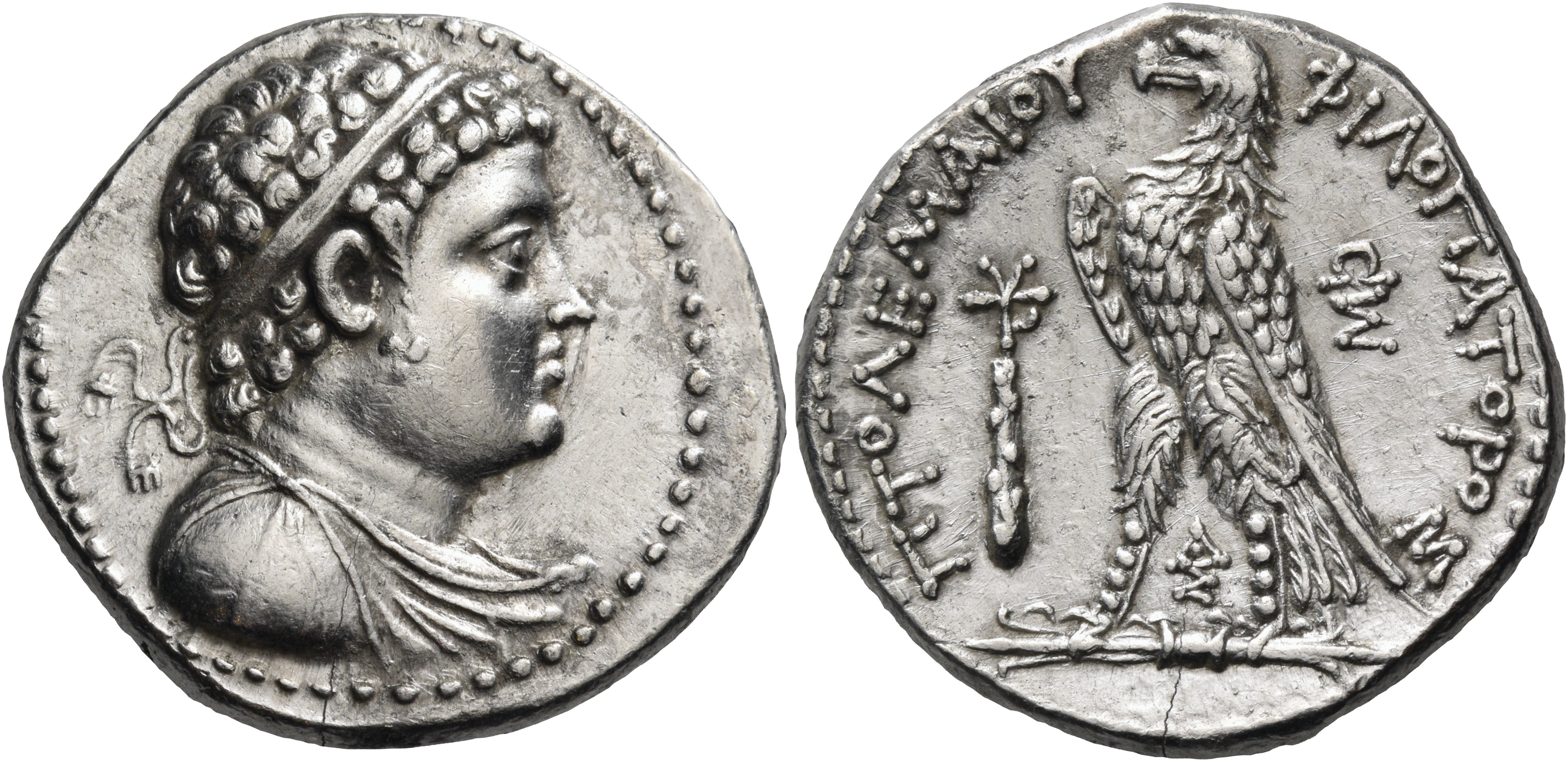Tyre (Ptolemy IV), silver, tetradrachms ΣΩ (portrait of Ptolemy IV) (217-215 BCE)
From SILVER
217 BCE - 215 BCE Silver 282 kg
Description
| ObverseInscription or printing placed on the obverse.: | Diademed and draped bust of Ptolemy IV to right, wearing Macedonian military chlamys |
| ReverseInscription or printing placed on the reverse.: | ΠTOΛEMAIOY ΦIΛOΠATOPOΣ (Greek).Eagle with closed wings standing to left on thunderbolt, to left, club surmounted by the monogram of Tyros, between eagle's legs, monogram of Δ•Σ, in field to right, monogram of ΣΩ |
Mint and issuing power
| MintIdentifies the place of manufacture or issue of a numismatic object.: | Tyre | Ancient regionAncient region.: | Phoenicia | Modern countryModern country: Lebanon | AuthorityIdentifies the issuing power. The authority can be "pretended" when the name or the portrait of X is on the coin but he/she was not the issuing power. It can also be "uncertain" when there is no mention of X on the coin but he/she was the issuing power according to the historical sources: | Ptolemaic dynasty (323-30 BC), Ptolemy I Soter (satrap and Ptolemaic king of Egypt, 323-305 BC), Ptolemy IV Philopator (Ptolemaic king, 221-205 BC) |
Chronology
| FromIdentifies the initial date in a range assigned in a numismatic context. | 217 BCE | toIdentifies the final date in a range assigned in a numismatic context.. | 215 BCE | PeriodTime period of the numismatic object.: Hellenistic 323-30 BC |
Physical description
| MetalThe physical material (usually metal) from which an object is made.: | Silver |
Median weightMedian of the weights of numismatic objects (in grams). in grams | 14.10 | DenominationTerm indicating the value of a numismatic object. Examples: tetradrachm, chalkous, denarius.: | tetradrachm |
StandardStandard.: | Ptolemaic |
Image

Tyre Ptolemy IV tetradrachms SO (Ptolemy IV).jpg [1]
References
| Die study referencePublication of the study: | Carlen 20221Carlen 2022, p. 57-58, n° 30-42 | ||
| Coin series referenceReference to coin series study: | Sear II2Sear II, n° 7827 (var.), CPE I3CPE I, n° 921-925 | ||
| Coin series web referenceCoin series web references: | |||
Obverse dies distribution
| FrequencyFrequency of specimen in distribution. ᵖ | Number of obversesNumber of obverse dies. ᵖ (o) | % (o) | Number of coinsNumber of coins. (n) | % (n) | Die nameName(s) of the die(s). |
| 13 | 1 | 100 | 13 | 100 | 3 |
| Total | 1 of 1 | 100 | 13 of 13 | 100 |
Reverse dies distribution
no distribution is available
Quantification
| Number of obversesNumber of obverse dies. ᵖ (o) | 1 | Number of singletons (o1)The number of singleton coins. ᵖ | |
| Number of reverse diesNumber of reverse dies. (r) | 5 | Number of coinsNumber of coins. (n) | 13 |
| Coins per obverse dieNumber of coins per obverse die. (n/o) | 13 | Coins per reverse dieNumber of coins per reverse die. (n/r) | 2.6 |
| Reverse per obverse ratioRatio of obverse dies divided by reverse dies. (r/o) | 5 | Percentage of singletons (o1)number of coins (n) divided by the number of singletons (o1) ᵖ | % |
| Original number of dies (O) (Carter 1983 formula)The estimation of the number of coins according to Carter 1983 ᵖ | 1 | Coins struck if 20,000 as average productivity per dieCoins made if the average productivity for obverses (according to Carter) is 20,000. ᵖ | 20,000 |
| Original number of dies (O) (Esty 2011 formula)The estimation of the number of coins according to the singleton formula in Esty 2011 ᵖ (O) | 1.08 | Survival rate if 20,000 as average productivity per dieSurvival rate if average productivity is 20,000. ᵖ | 0.00065 |
| Coverage (o = % of O) (Esty 1984 formula)Esty 1984 - coverage (% of O) ᵖ (o = % of O) | % | Die productivity if survival rate 1/2,000Average productivity if survival rate is 1/2,000. ᵖ | 26,000 |
| Weight of silver (in kg) if 20,000 coins per die (O = Carter formula)Carter 1983 * Median weight * 20000 (*10 if gold or electrum) ᵖ | 282 kg <br /> 282 kg | Die productivity if survival rate 1/5,000Average productivity if survival rate is 1/5,000. ᵖ | 65,000 |
Remarks
Most likely one single workstation Likely military
References
- ^ Carlen, Eric (2022), "The Silver ΣΩ Coinage of Ptolemy IV and Related Issues," Israel Numismatic Research, 17, p. 51-69.
- ^ Sear, David R. (1979), Greek coins and their values. Vol. II, Asia and North Africa, London, xlviii, p. 317-762
- ^ Lorber, Catharine C. (2018), Coins of the Ptolemaic empire : Part I. Ptolemy I through Ptolemy IV, 2 vol., New York.